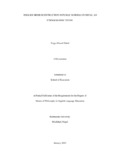
Please use this identifier to cite or link to this item:
https://hdl.handle.net/20.500.14301/126| Title: | ENGLISH MEDIUM INSTRUCTION IN PUBLIC SCHOOLS IN NEPAL: AN ETHNOGRAPHIC STUDY |
| Authors: | Dahal, Yagya Prasad |
| Citation: | Dahal, Y.P.(2023).English Medium Instruction in Public Schools in Nepal: An Ethnographic Study. |
| Issue Date: | Jan-2023 |
| Publisher: | Kathmandu University School of Education |
| School: | SOED |
| Department: | DOLE |
| Level: | M.Phil. |
| Program: | Master of Philosophy (MPhil) in English Language Education |
| Abstract: | English medium instruction (EMI) has been one of Nepal's most debated educational issues. It has heavily influenced the academic sectors in Nepal. Many public schools, particularly in urban areas, shifted the medium of instruction to English. This study aimed to explore the students’ perception on EMI in a public school. This study aimed to explore how eighth-grade students studying in a public school perceive EMI and its effects on their academic performance. This study delimited the perception of students studying in an English medium public school. I employed ethnography as a research method to study my research participants’ beliefs, actions, feelings, and experiences toward EMI. I selected four eighth-grade students, including one boy and three girls as my research participants. I explored students’ perception on EMI by observing context constantly and gathering information personally. Based on my research objectives, I recorded and jotted down my participants’ perceptions, experiences, feelings, and gestures on EMI. Similarly, I observed every activity minutely and then transcribed and generated themes and sub themes accordingly. To explicate my research participants’ beliefs, actions, feelings, and experiences towards EMI, I adopted Bourdieu’s language as symbolic power and linguistic, cognitive capital, Cummins’ CALP, and Vygotsky’s socio-cultural theory. To some extent, my participants believed English was the language of power, prestige, preference, and privilege. Based on my prolonged engagement with the participants and their perception, I explicated EMI from three perspectives: first, as an instrument to enhance the student’s English language proficiency, second as a barrier to the students ‘academic performance, and third, as an imposed and aggressive attempt to overshadow mother tongues/ first languages of the students. My study showed that EMI promoted rote learning and memorisation instead of enhancing students’ language proficiency and creativity. The study concludes that EMI is an important instrument for enhancing the English language proficiency of students. It is instrumental to creating career opportunities on the one hand and, whereas the other hand, the students’ home language or first language as a medium of instruction delivers quality education, enchaining socio-psychological advantages and sound academic achievement of the students. Therefore, using children's first language and EMI specifically to address basic-level students’ needs in a public school is a must. |
| URI: | http://101.251.6.110:8080/handle/20.500.14301/126 |
| Appears in Collections: | Dissertation |
Files in This Item:
| File | Description | Size | Format | |
|---|---|---|---|---|
| Yagya_Dahal_MPhil_ELE.pdf | 851.75 kB | Adobe PDF |  View/Open |
Items in DSpace are protected by copyright, with all rights reserved, unless otherwise indicated.